Solar eclipse of September 2, 2035
| Solar eclipse of September 2, 2035 | |
|---|---|
 Map | |
| Type of eclipse | |
| Nature | Total |
| Gamma | 0.3727 |
| Magnitude | 1.032 |
| Maximum eclipse | |
| Duration | 174 sec (2 m 54 s) |
| Coordinates | 29°06′N 158°00′E / 29.1°N 158°E |
| Max. width of band | 116 km (72 mi) |
| Times (UTC) | |
| Greatest eclipse | 1:56:46 |
| References | |
| Saros | 145 (23 of 77) |
| Catalog # (SE5000) | 9586 |
A total solar eclipse will occur on September 2, 2035. A solar eclipse occurs when the Moon passes between Earth and the Sun, thereby totally or partly obscuring the image of the Sun for a viewer on Earth. A total solar eclipse occurs when the Moon's apparent diameter is larger than the Sun's, blocking all direct sunlight, turning day into darkness. Totality occurs in a narrow path across Earth's surface, with the partial solar eclipse visible over a surrounding region thousands of kilometres wide.
Images
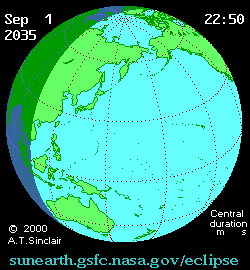
Animated path
Related eclipses
Solar eclipses of 2033-2036
Each member in a semester series of solar eclipses repeats approximately every 177 days and 4 hours (a semester) at alternating nodes of the Moon's orbit.
| Solar eclipse series sets from 2033-2036 | ||||||
|---|---|---|---|---|---|---|
| Ascending node | Descending node | |||||
| 120 | March 30, 2033 Total |
125 | September 23, 2033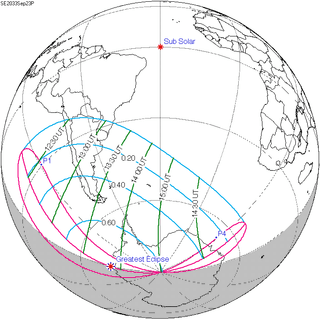 Partial | |||
| 130 | March 20, 2034 Total |
136 | September 12, 2034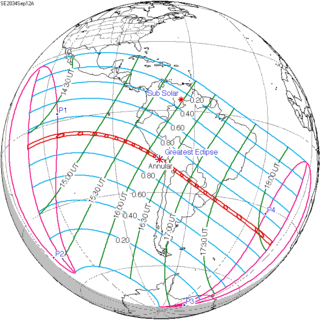 Annular | |||
| 140 | March 9, 2035 Annular |
145 | September 2, 2035 Total | |||
| 150 | February 27, 2036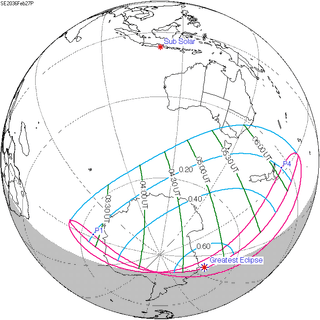 Partial |
155 | August 21, 2036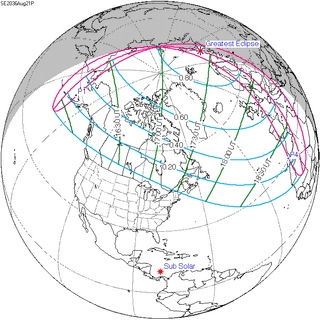 Partial | |||
| A partial solar eclipse on July 23, 2036 occurs in the next lunar year eclipse set. | ||||||
Saros 145
This solar eclipse is a part of Saros cycle 145, repeating every 18 years, 11 days, containing 77 events. The series started with partial solar eclipse on January 4, 1639, and reached a first annular eclipse on June 6, 1891. It was a hybrid event on June 17, 1909, and total eclipses from June 29, 1927 through September 9, 2648. The series ends at member 77 as a partial eclipse on April 17, 3009. The longest eclipse will occur on June 25, 2522, with a maximum duration of totality of 7 minutes, 12 seconds. [1]
| Series members 16–26 occur between 1901 and 2100 | ||
|---|---|---|
| 16 | 17 | 18 |
 June 17, 1909 |
 June 29, 1927 |
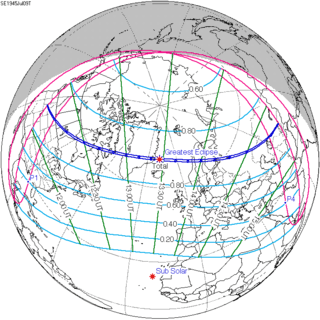 July 9, 1945 |
| 19 | 20 | 21 |
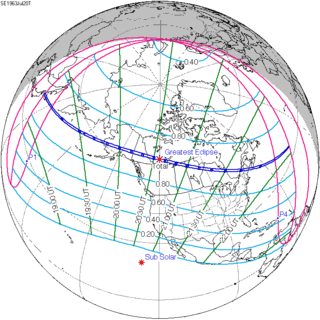 July 20, 1963 |
 July 31, 1981 |
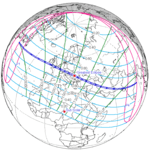 August 11, 1999 |
| 22 | 23 | 24 |
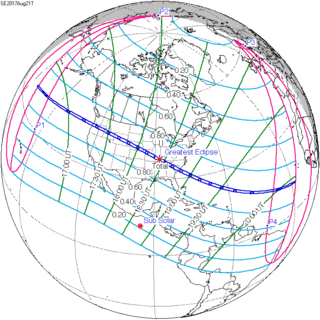 August 21, 2017 |
 September 2, 2035 |
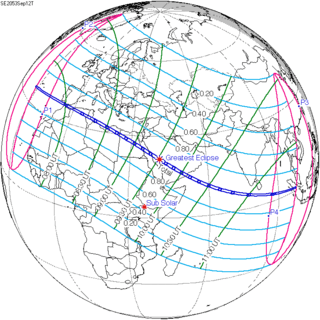 September 12, 2053 |
| 25 | 26 | |
 September 23, 2071 |
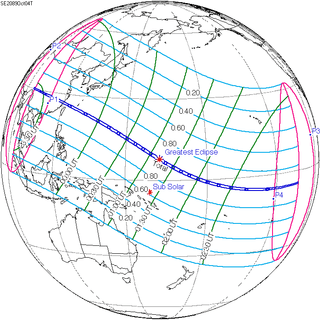 October 4, 2089 | |
Metonic series
The metonic series repeats eclipses every 19 years (6939.69 days), lasting about 5 cycles. Eclipses occur in nearly the same calendar date. In addition the octon subseries repeats 1/5 of that or every 3.8 years (1387.94 days).
| 21 eclipse events between June 21, 1982, and June 21, 2058 | ||||
|---|---|---|---|---|
| June 21 | April 8-9 | January 26 | November 13-14 | September 1-2 |
| 117 | 119 | 121 | 123 | 125 |
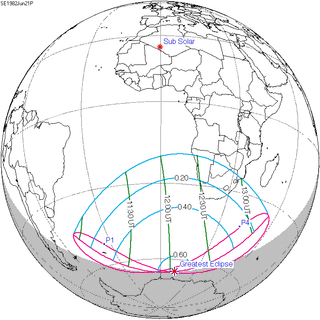 June 21, 1982 |
 April 9, 1986 |
 January 26, 1990 |
 November 13, 1993 |
 September 2, 1997 |
| 127 | 129 | 131 | 133 | 135 |
 June 21, 2001 |
 April 8, 2005 |
 January 26, 2009 |
 November 13, 2012 |
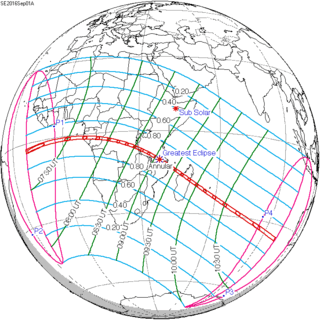 September 1, 2016 |
| 137 | 139 | 141 | 143 | 145 |
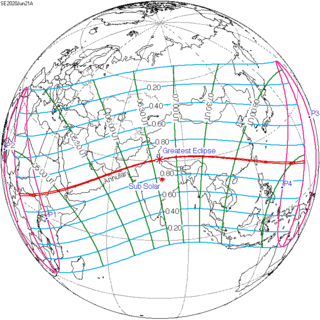 June 21, 2020 |
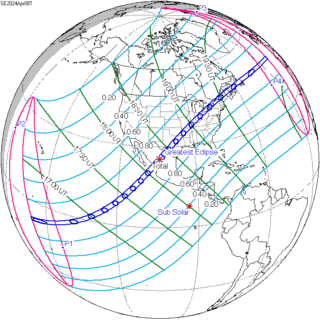 April 8, 2024 |
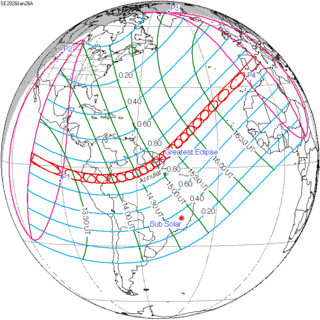 January 26, 2028 |
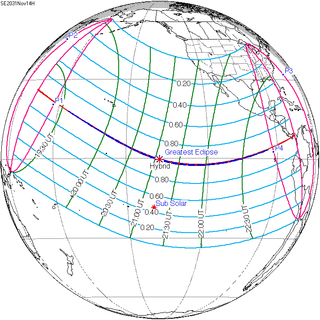 November 14, 2031 |
 September 2, 2035 |
| 147 | 149 | 151 | 153 | 155 |
 June 21, 2039 |
 April 9, 2043 |
 January 26, 2047 |
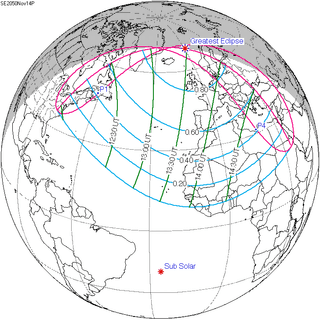 November 14, 2050 |
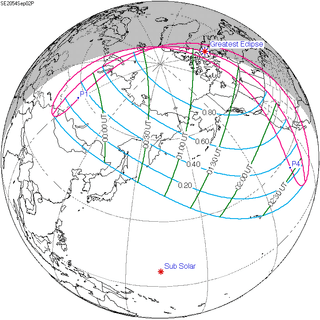 September 2, 2054 |
| 157 | ||||
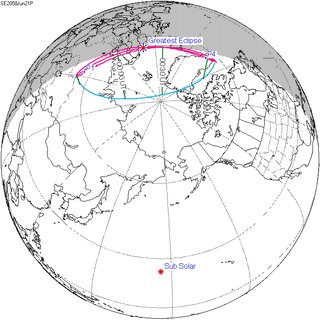 June 21, 2058 | ||||
References
- ↑ Espenak, Fred (Project & Website Manager), Statistics for Solar Eclipses of Saros 145, NASA, updated 2009 September 26.
| Wikimedia Commons has media related to Solar eclipse of 2035 September 2. |
